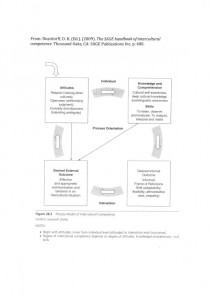Our second session of the learning series, Culture in the Classroom: Working with International Students, focused on intercultural competence models and cultural values frameworks. Mackenzie started us off with a mini-lecture outlining Darla Deardorff’s process model for intercultural competence, which looks like this (click on the image for a larger view):
This model explains the process of intercultural competence which is generally understood as the ability to handle and communicate both effectively and appropriately in a variety of cultural contexts. In the case of higher education, this definition can include the idea of educating effectively and appropriately by respecting the variety of cultural contexts that exist in a diverse and multicultural classroom (van der Poel, 2014). Deardorff’s model is one way at conceptualizing how individuals, and in our context, instructors, move toward intercultural competence. Individuals must begin with certain attitudes–having respect, openness, curiosity and discovery. From this point, individuals build their knowledge and understanding of both their own culture and the culture of others. Related to this, instructors also begin to develop skills such as listening and relational abilities. The next stage in the process is a shift in internal understanding through empathy and ethno-relative perspectives. Finally, by interacting in an intercultural situation the desired external outcome, or intercultural competence, is achieved through effective and appropriate communication or education.
After Mackenzie’s overview, the group discussed this model thoughtfully. Some of the points raised during that discussion included:
- Being able to achieve intercultural competence makes us better at getting along with many people, not just people from different cultures
- How does one gain knowledge, competence and skills, especially if they exist as a member of the dominant culture with little exposure to other cultures/ways of knowing?
- This model describes a process, not a linear step-by-step approach.
- One may appear to have the “right” attitudes on the surface, but these attitudes are not necessarily authentic.
From there, we discussed the video West and East: Cultural Differences and agreed that it offered a somewhat polarizing or dichotomizing look at Eastern vs Western ways of thinking. We acknowledged that the film-makers were attempting to make a point about perspectives, and succeeded in making somewhat blanket assumptions about which cultures think which way. Fortunately, we were a room full of critical thinkers, and were able to identify some of the more polarizing features of the film. Some members of our group did, however, recognized that the gist of the film was to raise our awareness that not all people, or all cultures, will have the same perspective. In this way, the film encourages us to consider our own ways of thinking, and acknowledge that there are potentially many ways of looking at the world, and in our case, many ways of looking at education.
We finished up the session by discussing some cultural values frameworks by Geert Hofstede, Fons Trompenaars, Mitch Hammer, and Edward T. Hall. The idea of cultural values frameworks was spearheaded by Geert Hofstede, a sociologist and anthropologist, in an effort to create a framework for cross-cultural communication. The discussion on cultural values frameworks once again raised concerns about the risks involved in oversimplifying, categorizing and/or dichotomizing culture. This ability to see the effects of polarizing culture speaks to the level of awareness, sensitivity and critical thought already apparent in the participants of the group. We were tasked to consider the categories of cultural values frameworks, and to try to look for examples of these values in our life and in our classrooms, to perhaps illustrate the applications Hofestede may have considered in creating this framework.
For the next session, we will be looking at pedagogical strategies and tips for working with diverse classrooms. Sylvia Arnold from the English Language Centre will be a guest speaker and will be facilitating a discussion around this topic. To prepare for this session, we have identified the following resources for your reading/skimming/viewing enjoyment:
Faculty handbook/how-to guide:
Arkoudis, S. (2014). Teaching international students: Strategies to enhance learning. Centre for the study of Higher Education, University of Melbourne:
Scholary Article:
Ryan, J. (2011). Teaching and learning for international students: Towards a transcultural approach. Teachers and Teaching: Theory and Practice, 17(6), 631-648.
Quick one-pages from Faculty Focus:
Pritchard, T. (2011). Supporting international students in the online environment. Faculty Focus: Higher Ed Teaching Strategies from Magna Publications.
Irish, C. & Scrubb, M. (2012). Five competencies for culturally competent teaching and learning. Faculty Focus: Higher Ed Teaching Strategies from Magna Publications.
Bista, K. (2011). A first-person explanation of why some international students are silent in the U.S. classroom. Faculty Focus: Higher Ed Teaching Strategies from Magna Publications.
VIU-created Videos:
The next session is on Thursday, October 16th from 3pm-5pm in Building 305; Room 444. Light refreshments will be served.
